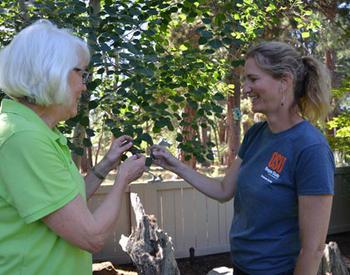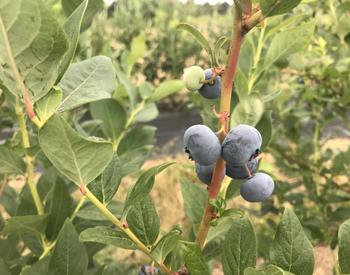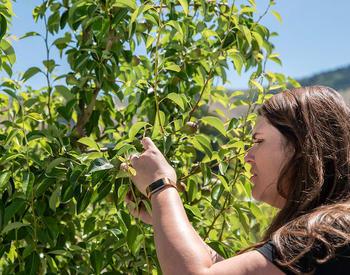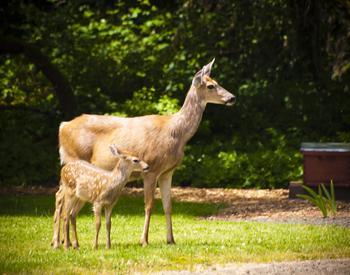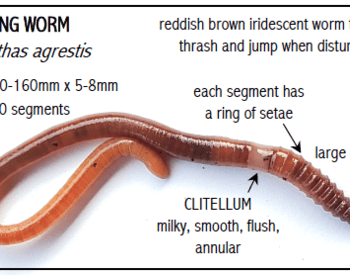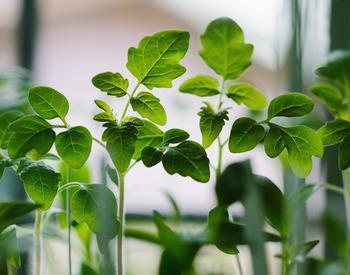Timely advice on garden chores, fertilizing, pest control, and more from OSU Extension.
These tips are not necessarily applicable to all areas of Oregon. For more information, contact your local Extension office.
Oregon State University Extension Service encourages sustainable gardening practices.
Practice preventive pest management rather than reactive pest control. Identify and monitor problems before acting, and opt for the least toxic approach. Conserve biological control agents such as predators and the parasitoids that feed on insect pests.
Planning
-
Write in your garden journal throughout the growing season.
-
Prepare garden soil for spring planting. Incorporate generous amounts of organic materials and other amendments, using the results of a soil analysis as a guide.
-
Prepare raised beds in areas where cold soils and poor drainage are a continuing problem. Incorporate generous amounts (at least 2 inches) of organic materials.
-
Use a soil thermometer to help you know when to plant vegetables. When the soil is consistently above 60 degrees Fahrenheit, some warm season vegetables (beans, sweet corn) can be planted.
Maintenance and cleanup
-
Allow foliage of spring-flowering bulbs to brown and die down before removing.
-
Apply commercial fertilizers, manure or compost to cane, bush (gooseberries, currants, and blueberries), and trailing berries.
-
Place compost or decomposed manure around perennial vegetables, such as asparagus and rhubarb.
-
Cut back ornamental grasses to a few inches above the ground.
-
Cover transplants to protect against late spring frosts.
-
This is an optimum time to fertilize lawns. Apply 1 pound nitrogen per 1,000 square feet of lawn. Reduce risks of runoff into local waterways by not fertilizing just prior to rain, and not overirrigating so that water runs off the lawn and onto the sidewalk or street.
-
Western Oregon: De-thatch and renovate lawns. If moss has been a problem, scratch the surface before seeding with perennial ryegrass.
-
Western Oregon: Prune and shape or thin spring-blooming shrubs and trees after blossoms fade.
-
Central/Eastern Oregon: If snow mold was a problem, scratch the surface. If turf damage is severe, seed with Kentucky bluegrass.
-
Central Oregon and higher elevations of eastern Oregon: Prune your deciduous trees and shrubs, using proper techniques.
Planting and propagation
-
Plant gladioli, hardy transplants of alyssum, phlox and marigolds, if weather and soil conditions permit.
-
It's a great time to start a vegetable garden. Among the vegetables you can plant, consider:
- Oregon Coast: Beets, cabbage, carrots, cauliflower, celery, chard, slicing cucumbers, endive, leeks, lettuce, onion sets, peas and potatoes.
- Western valleys, Portland, Roseburg, Medford: Broccoli, Brussels sprouts, cabbage, carrots, cauliflower, chard, chives, endive, leeks, lettuce, peas, radishes, rhubarb, rutabagas, spinach and turnips.
- Central Oregon and higher elevations of eastern Oregon (late April): Peas, radishes, lettuce, spinach and turnips.
- Columbia and Snake River valleys, Ontario: Snap and lima beans, beets, broccoli, Brussels sprouts, cabbage, carrots, cauliflower, chard, chives, sweet corn, slicing and pickling cucumbers, kohlrabi, leeks, lettuce, onion sets, parsnips, peas, potatoes, pumpkins, radishes, rhubarb, rutabagas, summer and winter squash, and turnips.
Pest monitoring and management
Use chemical controls only when necessary and only after thoroughly reading the pesticide label. First consider cultural, then physical and biological controls. Choose the least-toxic options, and use them judiciously. Some examples include insecticidal soaps, horticultural oils, botanical insecticides, and organic and synthetic pesticides.
-
Clean up hiding places for slugs, sowbugs and millipedes. Least toxic management options for slugs include barriers and traps. Baits are also available for slug control; use caution around pets. Read and follow all label directions prior to using baits or any other chemical control.
-
Monitor strawberries for spittlebugs and aphids; if present, wash off with water or use insecticidal soap as a contact spray. Follow label directions.
-
If necessary, spray apples and pears when buds appear for scab. See Managing Diseases and Insects in Home Orchards.
-
Cut and remove weeds near the garden to remove potential sources of plant disease.
-
Use floating row covers to keep insects such as beet leaf miners, cabbage maggot adult flies, and carrot rust flies away from susceptible crops.
-
Help prevent damping off of seedlings by providing adequate ventilation.
-
Southwest Oregon: Place pheromone traps in apple or pear trees in late April to monitor codling moth activity.
-
Western Oregon: Manage weeds while they are small and actively growing with light cultivation or herbicides. Once the weed has gone to bud, herbicides are less effective.
-
Western Oregon: Spray stone fruits, such as cherries, plums, peaches and apricots, for brown rot blossom blight, if necessary.
Trade-name products and services are mentioned as illustrations only. This does not mean that the Oregon State University Extension Service endorses these products and services or intends to discriminate against products and services not mentioned.



